
|
You entered: crescent
 X-Raying the Moon
X-Raying the Moon
31.08.1995
Above is a picture of the Moon taken in X-rays by the Roentgen Observatory Satellite ROSAT in 1990. This famous picture shows three distinct regions: a bright X-ray sky, a bright part of the Moon, and a relatively dark part of the Moon.
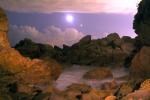 Moon and Venus over Corona Del Mar Beach
Moon and Venus over Corona Del Mar Beach
8.03.2004
The crescent Moon passed nearly in front of Venus last week. The close conjunction of the night sky's two brightest objects created a striking pose for many viewing the evening sky just after sunset. Such a pose, shown above, was captured between clouds over Corona Del Mar Beach in California, USA.
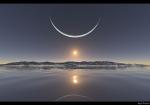 Hideaway
Hideaway
20.06.2006
Is this a picture of a sunset from Earth's North Pole? Regardless of urban legends circulating the Internet, the answer is no. The above scene was drawn to be an imaginary celestial place that would be calm and peaceful, and therefore titled Hideaway.
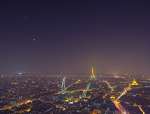 Paris by Night
Paris by Night
31.03.2012
Do you recognize the city lights of Paris in this picture? Taken on March 25 from the top of the 210 meter tall Montparnasse skyscraper, many will spot the looming Eiffel Tower, or the large domed structure of Les Invalides (right), or the colorfully lit elevated Metro train line gently curving toward picture center.
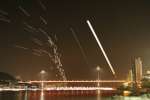 Hong Kong Sky
Hong Kong Sky
6.02.2010
This remarkable scene combines multiple exposures recorded on the evening of January 18th from a waterside perspective in Hong Kong, China. It follows a young crescent Moon, with brilliant planet Jupiter to its left, as they set together in the western sky. Their two luminous trails are faintly paralleled by trails of background stars.
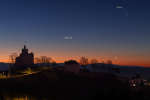 Good Morning Moon
Good Morning Moon
12.01.2024
Yesterday, the Moon was New. But on January 9, early morning risers around planet Earth were treated to the sight of an old Moon, low in the east as the sky grew bright before dawn.
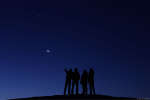 Contemplating the Sky
Contemplating the Sky
13.12.2010
Have you contemplated your sky recently? Tonight will be a good one for midnight meditators at many northerly locations as meteors from the Geminids meteor shower will frequently streak through. The Geminds meteor shower has slowly been building to a crescendo and should peak tonight.
 Wisps of the Veil Nebula
Wisps of the Veil Nebula
4.02.2003
These wisps of gas are all that remain visible of a Milky Way star. Many thousands of years ago that star exploded in a supernova leaving the Veil Nebula, pictured above. At the time...
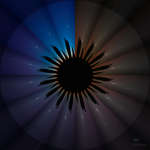 Twilight in a Flower
Twilight in a Flower
6.05.2023
Transformed into the petals of a flower, 16 exposures show the passage of day into night in this creative timelapse skyscape. Start at the top and move counterclockwise to follow consecutive moments as the twilight sky turns an ever darker blue and night blossoms.
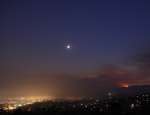 Planets and Fire by Moonlight
Planets and Fire by Moonlight
9.07.2008
On July 5th, wandering planets, bright stars, and a young crescent Moon graced western skies after sunset. Arrayed along the solar system's ecliptic plane, the three celestial beacons forming this skyscape's eye-catching line-up with the Moon are Saturn (upper left), then Mars, and finally Regulus, alpha star of the constellation Leo.
|
January February March April May June July |
|||||||||||||||||||||||||||||||||||||||||||||||||